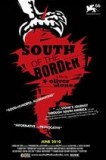| Reviews & Columns |
|
Reviews DVD TV on DVD Blu-ray 4K UHD International DVDs In Theaters Reviews by Studio Video Games Features Collector Series DVDs Easter Egg Database Interviews DVD Talk Radio Feature Articles Columns Anime Talk DVD Savant Horror DVDs The M.O.D. Squad Art House HD Talk Silent DVD
|
DVD Talk Forum |
|
|
| Resources |
|
DVD Price Search Customer Service #'s RCE Info Links |
|
Columns
|
|
|
South of the Border

Oliver Stone is no stranger to controversy. The politically minded filmmaker has always jumped into hot topics with both feet, and he's taken his lumps for doing it. Four years before Michael Moore snuck into Cuba to film parts of Sicko, Stone had gone there to interview Fidel Castro for his documentary Commandante. Stone's new essay film, South of the Border, is an extension of that previous effort. This time, he went down to South America to talk to the liberal leaders who are seen as part of a new movement to unite the continent and lessen any co-dependent relationships with their neighbors to the North.
Stone begins building South of the Border off a portrait of Venezuelan President Hugo Chavez. After a failed coup and jail time in the 1990s, Chavez transformed armed insurrection into democratic elections and has been the elected President of his country since 1999. He even survived a coup against him in the early 21st Century, escaping death and emerging stronger than ever. A student of Castro and Simón Bolivar, Chavez is seen as having spearheaded a movement that has spread throughout South America, causing shifts in power and a move toward socialism in Uruguay, Brazil, Argentina, and several other countries.
Naturally, this has made Chavez a thorn in the side of the U.S. government, especially since he has nationalized the oil companies in Venezuela and has limited outside involvement. Much of the reform throughout the region, in fact, has been centered on worker's rights, alleviating poverty, and taking control of the country's natural resources. Though seen as conquering heroes by their own people (for the most part), the world media, and particularly the U.S. spin doctors, label Chavez and his associates as dictators, mad men, and drug addicts, all in an attempt to undermine the self-actualization of a people. In Stone's eyes, this is a situation that is about money more than it is about politics or ideological disagreements.
It makes sense that, in the first five minutes of South of the Border, Oliver Stone tips his hat to Michael Moore by using an extended clip of Moore lambasting Wolf Blitzter and his media cohorts for not going tough on the Bush administration until they were well on their way out the door. Stone's allegiance is clear, as is his inspiration. South of the Border is political muckraking where the documentarian is going to take center stage, acting as interviewer and narrator. Knowing Stone, he was fully aware of the trouble this would invite, and he welcomes it. I seriously doubt I'll be the only one to bring it up.
Unfortunately, it's indicative of a serious problem that South of the Border has overall: it's a film with a point of view, and there is no room for any outside ideas. That is not inherently a terrible thing. Art should have a point of view, and too often we expect our artists to shy away from having strong opinions. Taking a hard line might not be the best idea, however, when one of your major arguing points is that the U.S. media has willfully misreported the story and skewed the facts to serve an agenda. By dismissing all detractors of Hugo Chavez, Cristina Kirchner, Evo Morales, et al., as being the stooges of moneymen and foreign influence, it doesn't make Stone look any better. At least pose a tough question or two, let your subjects dismantle actual criticism rather than unseen straw men.
For instance, the director lays a lot of the turmoil and the disinformation at the feet of the International Monetary Fund (IMF). They are the shadowy figure lurking in the corners of his conspiracy. I'll admit, I hadn't heard of the IMF prior to South of the Border, and I still am not exactly sure who they are or why they exist. Stone steers every interview toward them, but he never gets far enough into their business to make his charges stick. South of the Border is only 78-minutes long, it's not like there wasn't room.

When it comes right down to it, Oliver Stone seems far too enamored of his subjects to really give us the full picture. He can't do a warts-and-all portrait, because he refuses to believe there are any warts. If he were in high school, he'd have pictures of Hugo Chavez and Brazilian president Lula all over his locker. He shakes hands with Paraguay's Fernando Lugo and tells him what a gentle man he is, and he practically flirts with Cristina Kirchner. Worse, he attempts to humanize Chavez by having him ride a kid's bicycle, and he plays soccer with Morales. It's the worst kind of campaign politics, and it's about as effective as John Kerry windsurfing. Hell, the bike breaks because Chavez is too massive to be riding it. That's the kind of thing that would lose an election in America.
The sad thing is, Stone didn't need any of these antics. His subjects are all very charismatic, compelling speakers--hence their rise to office. They don't need to be shown glad handing with the populace or engaging in everyday activities. They also don't need to be treated with kid gloves, not if they are everything Stone says they are. They should be able to debunk any myths about themselves quite readily. The power of the subjects makes South of the Border worth watching, but not really a must-see. It's good to hear the other side of the story, and the political debate in the U.S. does stifle genuine alternative voices far too often, but Stone does himself no favors by remedying one extreme by wrapping himself in another.
Jamie S. Rich is a novelist and comic book writer. He is best known for his collaborations with Joelle Jones, including the hardboiled crime comic book You Have Killed Me, the challenging romance 12 Reasons Why I Love Her, and the 2007 prose novel Have You Seen the Horizon Lately?, for which Jones did the cover. All three were published by Oni Press. His most recent projects include the futuristic romance A Boy and a Girl with Natalie Nourigat; Archer Coe and the Thousand Natural Shocks, a loopy crime tale drawn by Dan Christensen; and the horror miniseries Madame Frankenstein, a collaboration with Megan Levens. Follow Rich's blog at Confessions123.com.
|
| Popular Reviews |
| Sponsored Links |
|
|
| Sponsored Links |
|
|
| Release List | Reviews | Shop | Newsletter | Forum | DVD Giveaways | Blu-Ray | Advertise |
|
Copyright 2024 DVDTalk.com All Rights Reserved. Legal Info, Privacy Policy, Terms of Use,
Manage Preferences,
Your Privacy Choices | |||||||











